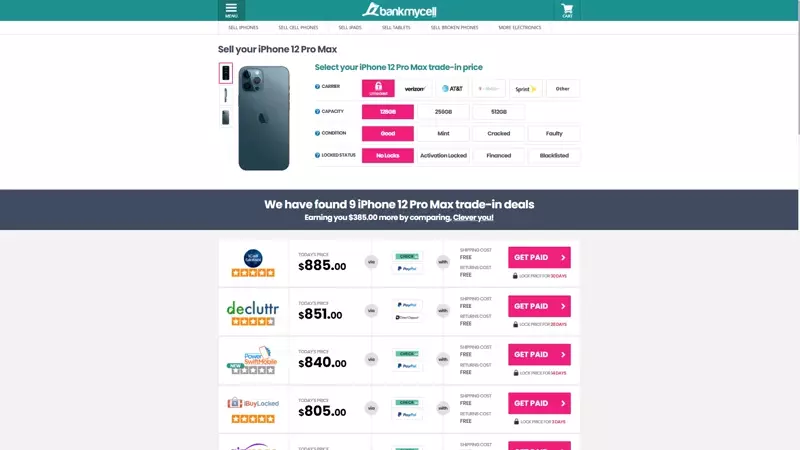What is a Blacklisted Phone: Definition and Solutions
- Learn what a blacklisted phone is and what you can do with it.
- Can you sell a blacklisted phone? Yes! Learn how.
- See what you can do if you buy a blacklisted mobile device.

What to Do With Your Blacklisted Phone?
What is a Blacklisted Phone?
A phone becomes blacklisted when it is reported lost or stolen by the prior or current owner. Alternatively, when there are outstanding or unpaid balances and bills, the phone carrier can report it as a blacklisted phone.
Can I Sell a Blacklisted Phone?
Today’s Top Price for Blacklisted
iPhone: $840.00
Samsung Galaxy: $470.00
It is possible to sell a blacklisted phone even if you are unable to clear the blacklist from the device (as long as you acquired it legally) or if you are still paying off the finance contract. However, the value of a blacklisted device will be significantly lower than an unlocked device.
Follow these steps to sell it:
- Find your device and select the “Blacklisted” status
- Choose storage and condition.
- Select a store, ship for free, and get paid.
How to Check If a Phone is Blacklisted?
- Find the phone’s IMEI number by dialing *#06# or asking the seller.
- Enter the IMEI number on IMEI 24.
How to Unlock a Blacklisted Phone?
- Contact your carrier and find out the reason for the blacklisting (AT&T, Verizon, Sprint, or T-Mobile). Settle any outstanding payments on the account to remove the blacklist.
- Use a third-party blacklist removal service like IMEI Authority, DirectUnlocks, or ExpressUnlocks. These services are not free and do not guarantee removal if you can’t prove that you own the phone.
- If the phone has been reported as lost or stolen phone by the previous owner, then unfortunately, the carrier will be unable to remove or unlock the blacklisted phone. Contact the previous owner to resolve the problem.
If you are unable to remove the blacklist status from your iPhone, it is still possible to sell the device.
In this article:
Have you ever wondered what a blacklisted phone is and how it will affect you? You are not alone. Many folks find themselves with a blacklisted phone and are unclear what to do next.
In this article, we cover all you need to know about blacklisted phones, whether they are Android phones or iPhones. This will work!
You’ll learn how to verify if your cell phone is blacklisted, what to do if you have one, and how to sell it.
#1 Rated Blacklisted Phone Buyer Online

Average Customer Rating:

5 out of 5 on Trustpilot
- Accepts: Blacklisted & Financed, Passcode or Activation Locked
- Reviews: #1 Rated, 800+ reviews on Trustpilot
- Payment: Pays you in 1-5 days via PayPal or Check
- Shipping: FREE Shipping & FREE Returns (NO RISK)
CUSTOMER TESTIMONIALS
What customers say about SellLocked.
Mitzi Roberts
Nicole Gibbs
What Does a Blacklist Mean on a Phone?
A blacklisted phone means you cannot access other phone carriers and, therefore, will not be activated until a phone carrier removes it from the list.
Since blacklist reports are internationally monitored and traced, iPhones that are blacklisted cannot avoid foreign systems of trade.
Who Decides Which Phones Are Blacklisted?
While it seems Apple would have the autonomy to blacklist an iPhone, this isn’t the case. Apple doesn’t blacklist iPhones due to their policy of not handling stolen devices. It’s up to phone carriers, such as AT&T or Verizon, to report lost or stolen phones.
The IMEI number (International Mobile Equipment Identity) allows carriers to identify cell phones. If someone reports the iPhone as stolen or lost, or if it contains unpaid balances and bills, the phone carrier will label the IMEI number as blacklisted.
Find the Best Deals for Your Blacklisted Devices Here!
BankMyCell provides an easy way to compare costs from reputable buyback stores. Get the most out of your device, ship it for free, and earn more while legally and ethically compliant.
How to Check if Your Phone is Blacklisted?
Step 1: Find your IMEI number:
- Dial *#06#.
- OR check your phone’s settings under About.
- OPTIONAL: On the battery, the phone box, or the back of the phone.
Step 2: Call your carrier with the number to verify.
- ALTERNATIVE: Enter in IMEI Pro (FREE) or IMEI 24 (FREE).
When you buy a used phone, you should always make sure and check if the phone is blacklisted with a bad IMEI (International Mobile Equipment Identity) or ESN (Electronic Serial Number) – or you’ll have a problem on your hands.
What to Do With a Blacklisted Phone?
How to Unlock Blacklisted Phone?
Are they purchased from a mobile service provider or carrier?
Inform the carrier of the blacklist status. They should help by either removing the phone from the blacklist or providing a refund. Most of the time, you would only need to pay your unpaid bills to get off the blacklist status.
Have you purchased a used phone from a private seller?
If you purchased a used phone from a private seller and it turned out it’s blacklisted, resolving it might be difficult. Contact the seller to request a refund or to have the phone removed from the blacklist. If the other party is uncooperative, consider taking the matter to small claims court or reporting it to the local authorities.
Use third-party blacklist removal service
Use a third-party blacklist removal service, such as IMEI Authority, DirectUnlocks, or ExpressUnlock. These services are not free and do not guarantee removal if you cannot demonstrate that you own the phone.
Can You Sell Blacklisted Phones?
Yes! You can sell blacklisted cell phones online via BankMyCell as long as you can prove you are the rightful owner or that you purchased a blacklisted or stolen device by accident.
How to Sell Blacklisted Phones?
- Find your phone’s model here.
- Select Blacklisted in the locked status and enter appropriate phone information.
- Click Get Paid and follow the instructions.
Alternatively, You can sell it through local pawn shops or repair shops, most of whom use these phones for parts.
#1 Rated Blacklisted Phone Buyer

Average Customer Rating:

5 out of 5 on Trustpilot
- Accepts: Blacklisted & Financed, Passcode or Activation Locked
- Reviews: #1 Rated, 800+ reviews on Trustpilot
- Payment: Pays you in 1-5 days via PayPal or Check
- Shipping: FREE Shipping & FREE Returns (NO RISK)
CUSTOMER TESTIMONIALS
What customers say about SellLocked.
Mitzi Roberts
Nicole Gibbs
FAQs
Can a blacklisted phone still be used?
Yes, you can still use a blacklisted phone. However, it won’t be able to work on most mobile networks. You can only watch movies, play games, or use as a Wi-Fi-only device.
What happens if I put my SIM card in a blacklisted phone?
If you install a SIM card into a blacklisted phone, you won’t be able to connect it to its cellular network. It is limited to Wi-Fi use and certain app features that do not require a cellular connection.
Is it illegal to sell a blacklisted phone?
Selling a blacklisted phone is not illegal as long as the seller is transparent about the phone’s status and does not engage in fraudulent behavior.
What does bad IMEI mean?
A bad IMEI means you can’t connect to cellular services. You won’t be able to make calls or send messages on your cell phone.
